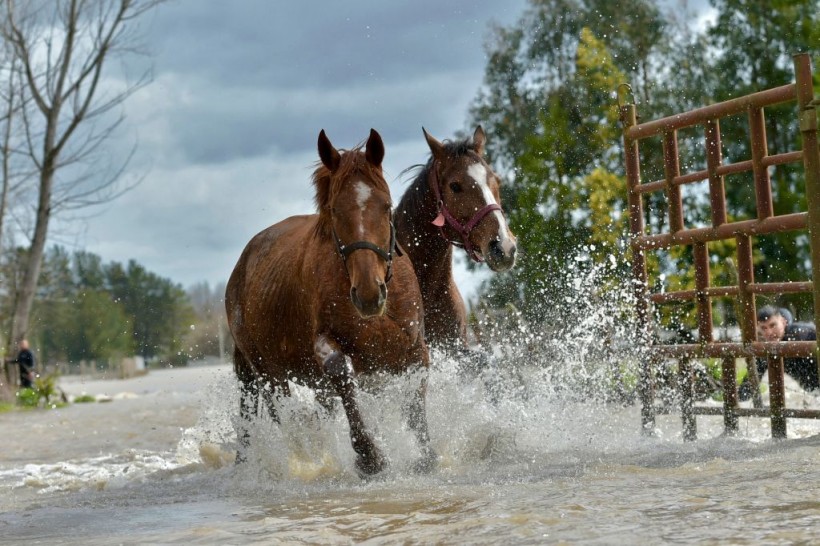Wild horses are fascinating animals that have roamed the earth for millions of years. They have adapted to various habitats and climates, and have developed complex social behaviors and interactions.
However, studying these behaviors in the wild is challenging, as wild horses are often elusive and wary of humans.
Fortunately, a new technology has emerged that allows researchers to observe wild horses from a safe distance and with minimal disturbance: drones.
The case of the Przewalski's horses
 (Photo : GUILLERMO SALGADO/AFP via Getty Images)
(Photo : GUILLERMO SALGADO/AFP via Getty Images)

One of the recent studies that used drones to study wildlife behavior focused on a group of Przewalski's horses in Hungary.
The study was conducted by researchers from the Hungarian Research Network (HUN-REN), the University of Debrecen (UD), the Eötvös Loránd University (ELTE) and the Hortobágy National Park Directorate.
They used drones to capture footage of Przewalski's horses in the Pentezug reserve. The footage revealed a complex social structure among the horses, with different groups of horses forming distinct communities.
The researchers identified four types of groups among the horses: harems, bands, bachelor groups, and loners.
Harems consisted of one dominant male and several females and their offspring. Bands were larger groups composed of two or more harems that stayed together for long periods.
Meanwhile, bachelor groups were made up of young males who had left their natal harems and were looking for mates, and loners were solitary males or females that did not belong to any group.
The researchers found that the groups had different patterns of movement and association. Harems tended to stay close together and move slowly across the landscape.
Bands were more dispersed and moved faster than harems. Bachelor groups were highly mobile and often changed their location and composition. Loners were unpredictable and sometimes joined or left other groups.
The researchers also discovered that the groups had different levels of social cohesion and stability.
Harems were the most cohesive and stable groups, as they rarely split or merged with other groups. Bands were less cohesive and stable than harems, as they sometimes split into smaller units or merged with other bands, while the bachelor groups were the least cohesive and stable groups, as they frequently split or merged with other bachelor groups or loners.
The researchers concluded that Przewalski's horses have a multilevel society, similar to some primates and elephants.
They suggested that this society may have evolved in response to environmental factors, such as food availability, predation risk, and human disturbance.
They also highlighted the importance of drones for studying Przewalski's horse behavior, as they provided a novel perspective and a wealth of data.
Also Read: Human Emotions Affect Animal Welfare for Horses, Pigs - Study Confirms
Drones as a tool for studying wild horse behavior
Drones are unmanned aerial vehicles that can fly over large areas and capture high-quality images and videos.
They can be controlled remotely or programmed to follow a predefined route. Drones have been used for various purposes, such as mapping, surveillance, delivery, and entertainment.
Recently, they have also been used for wildlife research, as they offer several advantages over traditional methods.
One of the advantages of drones is that they can access remote and rugged areas that are difficult or dangerous for humans to reach.
They can also cover more ground and collect more data in less time than ground-based observers.
Another advantage is that they can reduce the impact of human presence on wildlife behavior, as they are relatively quiet and inconspicuous.
This allows researchers to observe animals in their natural state, without altering their behavior or causing them stress.
Drones have been used to study various aspects of wildlife ecology and behavior, such as population size, distribution, habitat use, migration, reproduction, and social interactions.
Some of the animals that have been studied using drones include birds, whales, dolphins, seals, elephants, rhinos, giraffes, zebras, and wolves.
Related article: Horses have Night Eyes, Extra Toes, Vestigial Glands on Their Legs - or Do They?
© 2024 NatureWorldNews.com All rights reserved. Do not reproduce without permission.




![Roundworms with Short Memories 'Stop Forgetting' When Frozen or Given Lithium [Study]](https://1471793142.rsc.cdn77.org/data/thumbs/full/70295/280/157/50/40/roundworms-with-short-memories-stop-forgetting-when-frozen-or-given-lithium-study.jpg)
